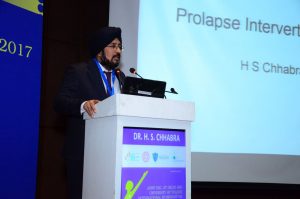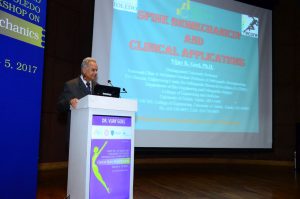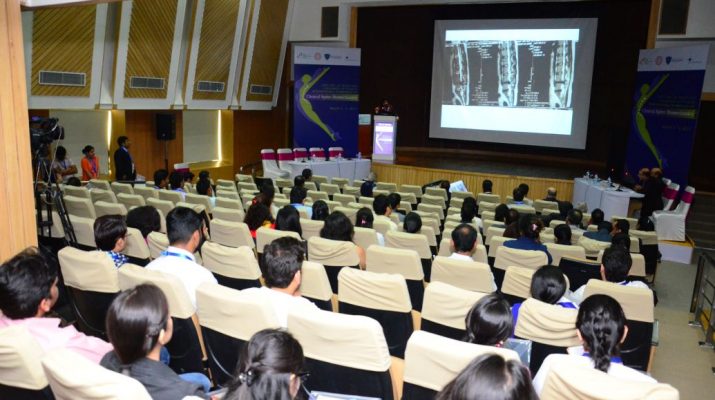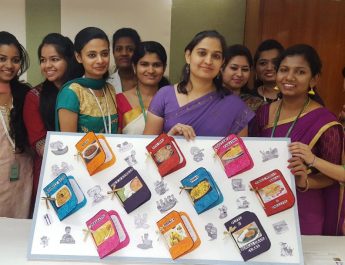International workshop organized at Indian Spinal Injuries Centre, New Delhi covers premiere aspects of the application of clinical biomechanics in treating spine-related ailments
Clinical biomechanics is a branch of medical science that uses traditional principles of mechanical engineering to analyze biological systems of human anatomy. Â With the increasing incidence of spinal ailments due to sedentary lifestyles, desk jobs, and workout injuries, there is greater need to integrate knowledge of biomechanics of the spine into prevention and treatment modalities, agreed experts at a major international conference organized by Indian Spinal Injuries Centre, Vasant Kunj in the national capital.
 The high-level international conference-cum-workshop on ‘Clinical Spine Biomechanics’ was organized jointly by ISIC in collaboration with the Spinal Cord Society (India chapter), IIT-Delhi, and University of Toledo, USA, and is centrally themed around the discussion of integration of biomechanics into treatment modalities and management of spinal cord injuries. More than 200 medical experts, orthopedic surgeons, academicians, biomechanical engineers, research scholars, rehabilitation professionals, and industry experts came together from around the globe to take part in the workshop.
The high-level international conference-cum-workshop on ‘Clinical Spine Biomechanics’ was organized jointly by ISIC in collaboration with the Spinal Cord Society (India chapter), IIT-Delhi, and University of Toledo, USA, and is centrally themed around the discussion of integration of biomechanics into treatment modalities and management of spinal cord injuries. More than 200 medical experts, orthopedic surgeons, academicians, biomechanical engineers, research scholars, rehabilitation professionals, and industry experts came together from around the globe to take part in the workshop.
“The spine is a complex but important structure of the human body, comprising of the vertebrae, and multiple cervical, thoracic, lumbar, sacral, and coccygeal segments. Of late, with phenomenal advancements in the management of spinal diseases, study of biomechanics has evolved into an indispensible part treating spine and spinal cord ailments. Spine biomechanics helps in accurately identifying and analyzing changes and pressures that impact the spine during different static and dynamic positions. For example, an increase in lumbar spine translational movement may result in lumbar disc degeneration or lower back pain,†explains Dr H S Chhabra, Chief of Spine Service & Medical Director at Indian Spinal Injuries Centre.
 Dr Vijay Goel, Co-Director, Engineering Centre for Orthopedic Research Excellence, University of Toledo said, “Intra-discal pressures vary with various positions and physical activities that we perform in our daily lives. As a matter of fact, disc pressure is a combined outcome of object weight, upper body weight, muscles forces, load sharing, and so on, and the kinematics of our bodies, and changes occurring internally owing to various factors including age, sex, stress and strain, or trauma. Our findings at the Engineering Centre for Orthopaedic Research Excellence (E-Core), have suggested that a combination of prolonged sitting and vibration along with adherence to sudden loads for 4 to 8 hours can increase the risk of back pain, which means that the average auto rickshaw driver or truck driver in India are usually prone to load alterations and can have huge problems of the neck and spine. Integrated clinical knowledge of biomechanics needs to come out of the textbooks and the practical aspects of this subject must be looked into carefully, which includes dealing with clinical, ergonomical, and surgical issues in orthopaedics. It can also help rehabilitation professionals as well as the industry at large (in designing advanced level inner implants for spine-related ailments).”
Dr Vijay Goel, Co-Director, Engineering Centre for Orthopedic Research Excellence, University of Toledo said, “Intra-discal pressures vary with various positions and physical activities that we perform in our daily lives. As a matter of fact, disc pressure is a combined outcome of object weight, upper body weight, muscles forces, load sharing, and so on, and the kinematics of our bodies, and changes occurring internally owing to various factors including age, sex, stress and strain, or trauma. Our findings at the Engineering Centre for Orthopaedic Research Excellence (E-Core), have suggested that a combination of prolonged sitting and vibration along with adherence to sudden loads for 4 to 8 hours can increase the risk of back pain, which means that the average auto rickshaw driver or truck driver in India are usually prone to load alterations and can have huge problems of the neck and spine. Integrated clinical knowledge of biomechanics needs to come out of the textbooks and the practical aspects of this subject must be looked into carefully, which includes dealing with clinical, ergonomical, and surgical issues in orthopaedics. It can also help rehabilitation professionals as well as the industry at large (in designing advanced level inner implants for spine-related ailments).”
Given the fact that this is the first time our country witnessed an advanced level international clinical workshop dedicated to spine biomechanics and its functional excellence, the conference aimed to deliver a 360 degree perspective on the causes, occurrence, and updated treatment mechanisms of various types spinal disorders.
“Spine disorders occurring due to degenerative lifestyle factors can impact a person’s mobility and other functional abilities over the long term and sometimes need rehabilitation. While most spinal cord injuries (SCI) are due to traumatic events, an increasing incidence of backaches and spinal ailments today are being attributed to sedentary lifestyles, deskjobs requiring long hours of sitting, lack of physical activity that weakens the back muscles, among others. Keeping this in mind, the workshop has focused on adapting a holistic approach towards implementing biomechanics as an integrated part of management and treatment of several spine-related ailments such as degenerative spine lumbar, degenerative cervical spine, thoracolumbar trauma, cervical trauma, osteoporotic spine fractures, and so on,†added Dr Chhabra.
As a part of the scientific agenda, a series of evidence-based case study presentations, lectures, hands-on training modules, and panel discussions took place involving 50+ faculties from reputed healthcare organizations and educational institutions of various states in India. Apart from Dr . Vijay Goel, Dr. Ali Ozer from Istanbul, Turkey (who is the pioneer in the medical practice of posterior dynamic systems) also delivered a special guest lecture.
India presently ranks second in the total number of spinal cord injury patients in the world, registering over 20,000 fresh cases every year. While accidental falls and slips are some of the causes of spinal injury, road accidents are the prime cause of spinal injuries in India and across the world, and pose a substantial risk of physical and emotional trauma among the victims.
With constantly evolving rapid urbanization and development and adhered lifestyle changes, spinal ailments are likely to increase in India in coming years, and the resultant health burden has now become a matter of concern. The workshop witnessed intense deliberations on highly relevant clinical topics including deformity correction, motion preservative surgery, spine trauma, sports injuries, and regenerative research.
The extensive two-day program includes a half-day brainstorming session highlighting the challenges and way forward of setting up a state-of-the-art clinical biomechanics laboratory in India. In this context, it must be noted that IIT-Delhi, University of Toledo, Hamburg University of Technology, and Stanford University have recently joined hands to set up the first-of-its-kind biomechanics laboratory at the premises of Indian Spinal Injuries Centre, which is expected to begin operations from next year.




